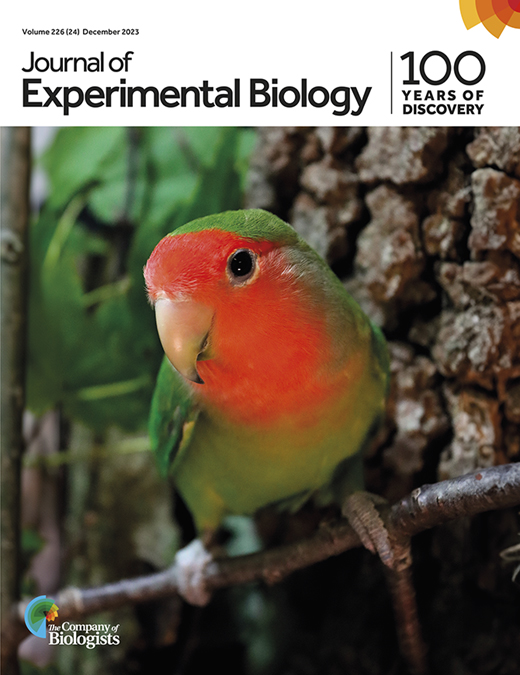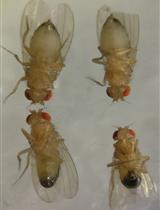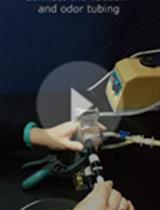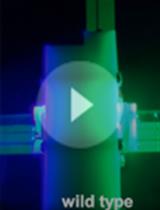- EN - English
- CN - 中文
Rearing and Shipping of Uranotaenia lowii, a Frog-Biting Mosquito
一种叮蛙蚊Uranotaenia lowii养殖和运输
发布: 2024年06月05日第14卷第11期 DOI: 10.21769/BioProtoc.4996 浏览次数: 1376
评审: Luis Alberto Sánchez VargasEmily Jane DennisRubikah Vimonish
Abstract
Many studies on mosquito biology rely on laboratory-reared colonies, emphasizing the need for standardized protocols to investigate critical aspects such as disease biology, mosquito behavior, and vector control methods. While much knowledge is derived from anthropophilic species from genera like Anopheles, Aedes, and Culex, there is a growing interest in studying mosquitoes that feed on non-human hosts. This interest stems from the desire to gain a deeper understanding of the evolution of diverse host range use and host specificity. However, there is currently a limited number of comprehensive protocols for studying such species. Considering this gap, we present a protocol for rearing Uranotaenia lowii, a mosquito species specialized in feeding on anuran amphibians by eavesdropping on host-emitted sound cues. Additionally, we provide instructions for successfully shipping live specimens to promote research on this species and similar ones. This protocol helps fill the current gap in comprehensive guidelines for rearing and maintaining colonies of anuran host–biting mosquitoes. It serves as a valuable resource for researchers seeking to establish colonies of mosquito species from the Uranotaeniini tribe. Ultimately, this protocol may facilitate research on the evolutionary ecology of Culicidae, as this family has recently been proposed to have originated from a frog-feeding ancestor.
Key features
• Rearing and maintenance of colonies of non-human host-biting mosquitoes that feed on frogs using host-emitted acoustic cues.
• Provides shipping guidelines aimed to enhance the establishment of colonies by new research groups and specimen exchanges between labs.
Keywords: Non-human host-biting mosquitoes (非人宿主叮咬蚊子)Background
An essential component in the comprehensive study of mosquitoes involves sustaining laboratory populations that allow experimental manipulations. Mosquito colonization enables in-depth exploration of life history traits, behavior, and the physiological mechanisms underlying them. Colonization of mosquitoes of medical importance, such as Anopheles gambiae, Aedes aegypti, and Culex pipiens, has, for instance, accelerated the rate of understanding of the biology of these anthropophilic species [1–4]. Establishing and maintaining robust and standardized mosquito colonies requires the development and application of well-established protocols as well as a good understanding of the key factors influencing mosquito fitness in captivity. Recent interest in mosquitoes that feed on non-human hosts has increased due to the increased recognition of the implications that mosquitoes feeding on other hosts can have in the ecosystem [5,6]. Until now, however, little was known regarding the rearing techniques and successful establishment of laboratory populations of mosquitoes with non-human hosts. Among those, mosquitoes that feed on frogs provide a valuable opportunity to understand the evolutionary ecology of Culicidae, as this family has recently been proposed to have originated from a frog-feeding ancestor [7]. While some mosquitoes are generalists and opportunistically feed on frogs as well as other hosts, other mosquitoes are specialized in feeding exclusively on anurans. The use of host-emitted acoustic signals, such as the mating calls of frogs for instance, is an adaptation that has evolved independently multiple times across flies and mosquitoes to detect and localize anuran hosts [8]. Among such frog-biting mosquitoes, Uranotaenia lowii is characterized by its preference for anuran hosts [9] and the use of auditory cues to locate them [10,11]. To date, no detailed documented studies have outlined protocols for maintaining laboratory colonies for Ur. lowii (but see Chapman [12]) or any other frog-biting mosquito species. Here, we present a standardized protocol for the rearing and colony maintenance of Ur. lowii mosquitoes. We also include a protocol for effectively shipping Ur. lowii specimens to promote specimen exchange between research groups.
Materials and reagents
Biological materials
Hosts for blood feeding
Uranotaenia lowii feed from anuran hosts in nature [9]. In contrast to mosquito species from genera like Aedes and Anopheles, which can often be raised using artificial blood diets [13], it is recommended to feed frog blood for the rearing of Ur. lowii. Field host surveys show that this species feeds on frogs from different families [9], so a variety of anuran species are likely to support a colony of Ur. lowii. We recommend, however, the following hosts to be used for blood feeding, as they successfully promote robust egg production: barking tree frog (Dryophytes gratiosus), Cuban tree frog (Osteopilus septentrionalis), cane toad (Rhinella marina), and southern toad (Anaxyrus terrestris) [12,11]. These anuran species can be procured from local shops or online stores (e.g., https://joshsfrogs.com/ or https://www.backwaterreptiles.com/).
Note: Protocols for using anurans for blood feeding must be approved by the appropriate Institutional Animal Care and Use Committee.
Uranotaenia lowii
This protocol describes the rearing and maintenance of Ur. lowii strain MFRU-FL (NCBI BioSample: SAMN33601576). It is to be expected, however, that these guidelines are transferable to other strains of this species. This protocol also provides a foundation for developing similar approaches to maintaining colonies of other Uranotaenia frog-biting species (i.e., de Silva et al. [14]). The colonies were originally established from egg rafts obtained from the USDA-ARS-CMAVE Mosquito and Fly Research Unit (Gainesville, FL, USA).
Reagents
Deionized water
Potbelly pig chow powder finely sieved (i.e., Mazuri® Mini Pig Youth); grind using a porcelain mortar and pestle (Letoyi, catalog number: B08LB3TJL4) and sieve through a fine mesh strainer (Clscea, catalog number: B0CBDFW92V)
Bovine liver powder (i.e., MP Biomedicals, catalog number: 290039601)
Brewer’s yeast (i.e., MP Biomedicals, catalog number: 290331205)
White sugar (e.g., Domino Cane Granulated Sugar, catalog number: 83FF)
Bleach (Clorox, catalog number: 30966, concentrated regular bleach)
70% ethanol (sterile 70% denatured ethanol) (Texwipe, catalog number: TX3265)
Solutions
Liver powder suspension (larval food) (see Recipes)
Sucrose solution [10% (w/v) adult food] (see Recipes)
Recipes
Liver powder suspension (larval food)
Reagents Quantity or Volume Bovine liver powder 3 g Brewer’s yeast 2 g Deionized H2O 100 mL Note: Shake well before each use. Can be stored at 4 °C for a week.
Sucrose solution (adult food)
Reagents Quantity or Volume White sugar (e.g., Domino Cane Granulated Sugar) 10 g Deionized H2O 100 mL Note: Mix the reagents well before use.
Laboratory supplies
While we provide manufacturers’ names and models for some items, we are not endorsing or promoting those specific products. Instead, we offer them as examples and, when possible, suggest low-cost alternatives to facilitate accessibility for a wider range of laboratories.
Cotton balls, size: 5 cm, prepared using any cotton roll (e.g., Intrinsics, catalog number: 227200)
Transfer pipettes [Fisherbrand Transfer Pipette, 4.6 mL (Fisher Scientific, catalog number: 13-711-274MD)], or wood applicator sticks (i.e., Fisher Scientific, catalog number: 22-363-158), or plastic spoons obtained from stores for transferring egg rafts
Scissors (8-inch titanium scissors) (Westcott, catalog number: 13901)
Brown, non-white, seed germination paper (38-lb regular weight creped seed germination paper) (Anchor Paper Company, catalog number: NC1466201). Prepare strips of 17.5 cm length × 8 cm width using scissors
Labeling tape (Write-On label tape, white, 1/2" roll) (Research Products International Corp, catalog number: 560172)
Manual insect aspirator (Forestry Suppliers, catalog number: 53758)
Digital thermometer and hygrometer (i.e., ThermoPro TP49 Digital Hygrometer; temperature range: 14 °C–70 °C; humidity range: 10%–99%)
Oviposition and emergence cups: plastic cup (Rubbermaid 2-Cup, catalog number: 7J60)
Larval rearing trays; plastic trays, size: 38 cm length × 30 cm width × 7 cm depth (any polypropylene plastic tray can be used, e.g., United Scientific Supplies, catalog number: 81702)
Shipping supplies
Cardboard box (small to medium to fit the Styrofoam box; Uline outer shipping carton with insulated Foam Shipping Kit, catalog number: S-12682)
Styrofoam box with a lid (Uline Insulated Foam Shipping Kit, catalog number: S-12682)
Bubble wrap (Uline Air Bubble Wrap Roll, catalog number: S-5120)
Small Petri dishes (i.e., one 75 mm diameter petri dish can contain around 10 egg rafts) (non-sterile transparent Polypropylene Petri dish: United States Plastic Corp., catalog number: 89824)
Germination paper cutout in circles (diameter determined by Petri dish diameter) (Anchor Paper Company, 38 lb regular weight creped seed germination paper, catalog number: NC1466201)
Ice packs (two minimum) (Uline cold packs, catalog number: S-7890)
Industrial tape 2 Mil (Uline, catalog number: S-423)
Equipment
Environmental chamber
The use of environmentally controlled chambers (insectaries) dedicated to mosquito rearing is encouraged (e.g., Percival WE-35VL, Boone, IA). However, it is possible to maintain the colony in a small room in which temperature and humidity are maintained close to target values (temperature: 22–28 °C, humidity 50%–80%, 12:12 h light/dark photoperiod).
Note: If there is no environmental chamber, the relative humidity within the cage can be increased by placing a humidifier (e.g., Vick humidifier, catalog number: V745A/V745-JUV; not restricted to any specific manufacturer) near the rearing cage and covering the entire setup with a plastic shelf cover (e.g., Formosa covers premium wire shelf cover, heavy-duty storage solution for wire shelving rack, #shelf 4919 pvc off white). The humidifier must be regularly filled with deionized water to regulate the relative humidity in the enclosure.
Frog restraining cage
A cylindrical cage (height: 8 cm; diameter 12 cm) made entirely of mesh. The top mesh can be replaced by an acrylic circular sheet (i.e., PET Thick Plexiglass sheet; 3 mm, Uline Acrylic sheet, catalog number: S-22486) to observe blood-feeding behavior during experiments. The frog restraining cage should be made of a robust mesh that has holes big enough (1 cm) for the mosquitoes to enter but not too large for the frog to escape (e.g., Home Intuition Heavy Duty Plastic Gutter Guards Mesh, catalog number: B07D91Y8BC).
Note: The use of a frog restraining cage is essential for limiting the movement of the frogs to increase the likelihood of blood feeding. Limited host movement promotes feeding opportunities and reduces frog defensive behaviors such as swatting, a common strategy used by anurans to repel attacking mosquitoes and midges (i.e., de Silva et al. [15]). Additionally, restraining the frogs prevents them from consuming mosquitoes. It is also advisable to provide a substantial meal for the frog before placing it in the restraining cage, so they are less motivated to eat the mosquitoes.
Mosquito rearing cage
Mosquito cages that provide access through a sleeve (e.g., BioQuip lightweight aluminum collapsible cages; 46 cm × 46 cm × 46 cm; 2 mm × 2 mm mesh size; Mosquito Rearing Cage, catalog number: 4S4545).
Procedure
文章信息
版权信息
© 2024 The Author(s); This is an open access article under the CC BY license (https://creativecommons.org/licenses/by/4.0/).
如何引用
Singh, R., Sanscrainte, N. D., Estep, A. S., González, K. and Bernal, X. E. (2024). Rearing and Shipping of Uranotaenia lowii, a Frog-Biting Mosquito. Bio-protocol 14(11): e4996. DOI: 10.21769/BioProtoc.4996.
分类
环境生物学 > 生态系统
神经科学 > 行为神经科学 > 实验动物模型
神经科学 > 行为神经科学 > 感觉运动反应
您对这篇实验方法有问题吗?
在此处发布您的问题,我们将邀请本文作者来回答。同时,我们会将您的问题发布到Bio-protocol Exchange,以便寻求社区成员的帮助。
Share
Bluesky
X
Copy link












